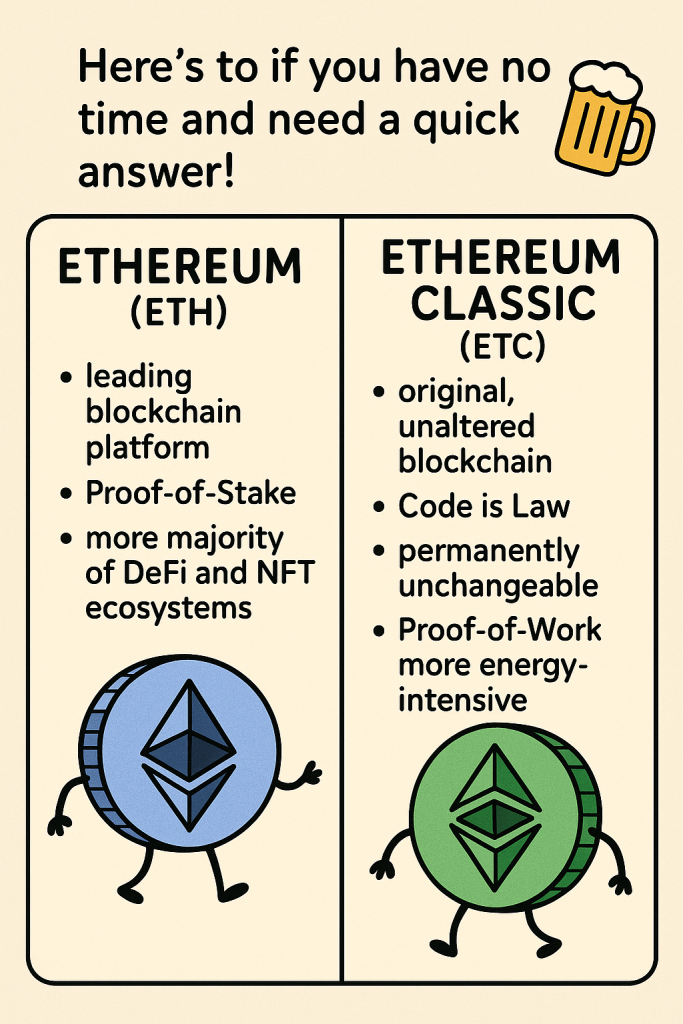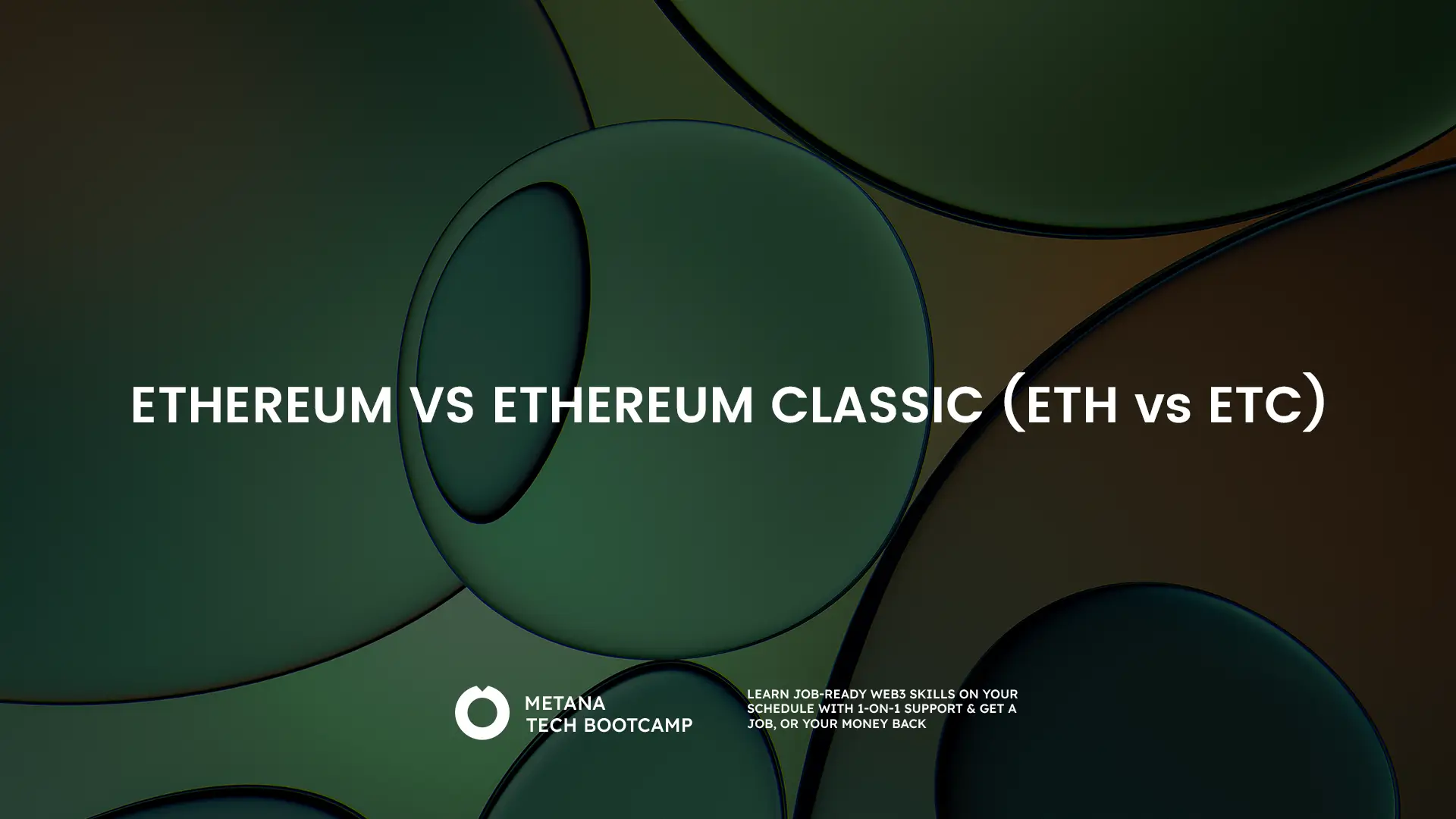TL;DR: Ethereum vs. Ethereum Classic
- Ethereum Classic is the original blockchain that maintained the 2015 code and philosophy
- Ethereum uses Proof of Stake while Ethereum Classic sticks with Proof of Work
- Both support smart contracts and dApps with similar technical capabilities
- Ethereum has a larger ecosystem with more developers and institutional support
- Ethereum Classic prioritizes immutability while Ethereum focuses on innovation
- Your choice depends on whether you value stability or constant evolution
Let’s be clear: Ethereum and Ethereum Classic are two huge names in today’s crypto world, but they’re different by design. Both have shot up in value, becoming top choices for investors.
What Is The key difference Between Ethereum and Ethereum Classic?

Here’s to if you have no time and need a quick answer!
Ethereum (ETH) is the leading blockchain platform that recently transitioned to a Proof-of-Stake system. This upgrade made it significantly more energy-efficient and scalable. It currently powers the vast majority of the decentralized finance (DeFi) and Non-Fungible Token (NFT) ecosystems.
Ethereum Classic (ETC), Ethereum Classic (ETC), conversely, represents the original, unaltered blockchain that strictly adheres to its “Code is Law” principle, ensuring its history remains permanently unchangeable. It continues to operate on the Proof-of-Work (PoW) consensus mechanism, which is more energy-intensive.
| Feature | Ethereum (ETH) | Ethereum Classic (ETC) |
|---|---|---|
| Consensus Mechanism | Proof of Stake | Proof of Work |
| Development Philosophy | Innovation and adaptation | Immutability and “code is law” |
| Token Supply | Unlimited (with burning) | Capped at 210 million |
| Block Time | ~12 seconds | ~13 seconds |
| Transactions per Second | 15 (base layer) + Layer 2 | 25 (base layer only) |
| Developer Ecosystem | Large and active | Small but dedicated |
| Energy Consumption | Very low (PoS) | High (PoW) |
| Smart Contracts | Full support | Full support |
| Virtual Machine | EVM compatible | EVM compatible |
| DApp Support | Extensive ecosystem | Limited ecosystem |
This guide will break down these two powerful networks simply, helping you see which might be the better fit for you.
What Sparked the Ethereum vs Ethereum Classic Split

The community had two choices: reverse the hack through a hard fork or let the consequences stand.
The majority voted for the hard fork, creating what we now call Ethereum. The minority, believing in “code is law” and blockchain immutability, continued with the original chain, naming it Ethereum Classic.
This philosophical split created two entirely different ecosystems with different visions for the future of blockchain technology.
Understanding this history helps explain why these networks developed such different characteristics over time.
WHAT IS ETHEREUM ?
Ethereum is an open, community-built platform that provides global access to digital money and decentralized services. According to Ethereum.org, it offers “open access to digital money and data-friendly services for everyone no matter your background or location.”
Even during the crypto market slump, Ethereum has remained strong, especially as the most popular cryptocurrency for buying NFTs. It continues to hold second place among cryptocurrencies.
Anyone with an internet connection can access Ethereum at any time. Its decentralized finance system runs around the clock, letting users earn, send, borrow, or trade from anywhere in the world. It is also secure and private since all you need is a wallet, with no need to share personal information.
WHAT IS ETHEREUM CLASSIC ?
Another open source blockchain that emerged from the 2016 Ethereum breach is Ethereum Classic. All of the money that were taken were returned as a result of the big fork.
Unlike Ethereum, the supply of Ethereum classic is limited 210,700,000 coins.
The “Code is law” principle, which is defined as a type of regulation in which technology is utilized to enforce preexisting laws, is the core goal of Ethereum Classic. They are currently observing a new trend where technology is steadily gaining the upper hand over these rules due to the introduction of Blockchain and Machine Learning.
Key Differences Between Ethereum and Ethereum Classic
1. Consensus Mechanism
The biggest technical difference lies in how these networks secure themselves and validate transactions.
Ethereum transitioned from Proof of Work to Proof of Stake in 2022, making it significantly more energy efficient. Validators stake their ETH to secure the network and earn rewards. This change reduced Ethereum’s energy consumption by over 99% and opened doors for new scaling solutions. If you’re learning about blockchain development, understanding this transition is crucial for modern dApp creation.
Ethereum Classic continues to use the Proof of Work consensus algorithm, similar to Bitcoin. Miners solve complex mathematical puzzles to validate transactions and secure the network. This approach requires significant computational power and energy but provides the security model that Bitcoin has proven over many years.
This fundamental difference impacts everything from energy consumption to transaction costs and long term network security models.
2. Development Philosophy and Governance
The philosophical divide runs deep between these networks and influences every major decision.
Ethereum takes a pragmatic and adaptable approach. The Ethereum Foundation actively develops upgrades, implements major changes like the Merge to Proof of Stake, and prioritizes scalability and mainstream adoption. The community regularly votes on improvement proposals and embraces change when it benefits users. This flexibility has enabled Ethereum to become the foundation for DeFi development and numerous other applications.
Ethereum Classic maintains a focus on decentralization, immutability, and censorship resistance. The community believes the blockchain should remain largely unchanged, with “code is law” as their guiding principle. They argue that reversing the DAO hack set a dangerous precedent for future interventions.
PRO TIP:
If you value immutability above all else, ETC aligns with your philosophy. If you prefer innovation and adaptation, ETH is your choice.
3. Token Supply and Monetary Policy
The two networks handle their economic models quite differently, which affects long term value propositions.
Ethereum has no hard cap on its total supply, meaning new ETH can theoretically be created indefinitely. However, the network implements burning mechanisms that remove ETH from circulation with each transaction. Since the London upgrade, more ETH gets burned during high network activity than new ETH gets created, making it potentially deflationary.
Ethereum Classic adopted a more Bitcoin inspired approach with a capped maximum supply of approximately 210 million ETC tokens. This creates built in scarcity and follows a more predictable issuance schedule. New ETC creation decreases over time through scheduled reductions, similar to Bitcoin’s halving events.
4. Network Performance and Scalability
Performance characteristics vary significantly between the networks due to their different development paths and technical choices.
Ethereum processes transactions with an average block time of about 12 seconds. The network can handle approximately 15 transactions per second at the base layer, but Layer 2 solutions like Polygon and Arbitrum dramatically increase throughput. Ethereum’s roadmap includes sharding and other scalability improvements that will further boost performance. Learning smart contract development on Ethereum gives you access to these advanced scaling solutions.
Ethereum Classic maintains slightly slower block times at around 13 seconds and can process up to 25 transactions per second. While this sounds faster than Ethereum’s base layer, ETC lacks the extensive Layer 2 ecosystem that makes Ethereum much more scalable in practice.
The user experience differs significantly when networks get congested, with Ethereum offering more options to maintain reasonable fees and speeds.
5. Developer Activity and Ecosystem Size
The development activity tells a clear story about each network’s momentum and future potential.
Ethereum boasts the largest developer ecosystem in cryptocurrency, with thousands of active projects, DeFi protocols, and NFT marketplaces. Major upgrades happen regularly with broad community consensus. The network hosts over 3,000 active dApps and processes billions of dollars in transactions daily. This massive ecosystem creates network effects that attract even more developers and users.
Ethereum boasts the largest developer ecosystem in cryptocurrency, with thousands of active projects, DeFi protocols, and NFT marketplaces. Major upgrades happen regularly with broad community consensus. The network hosts over 3,000 active dApps and processes billions of dollars in transactions daily. This massive ecosystem creates network effects that attract even more developers and users.
Ethereum Classic has a smaller but dedicated development team. The network supports fewer active projects and receives less frequent updates. While this creates a more stable environment, it also means slower progress on scaling solutions and fewer innovative applications.
Core Similarities Between ETH and ETC
Despite their differences, both networks share fundamental characteristics from their common origin that make them surprisingly compatible.
1. Smart Contract Functionality
Both Ethereum and Ethereum Classic support identical smart contract capabilities. You can deploy the same Solidity code on both networks with minimal modifications. This means developers who learn Solidity programming can work on either platform.
Both Ethereum and Ethereum Classic support identical smart contract capabilities. You can deploy the same Solidity code on both networks with minimal modifications. This means developers who learn Solidity programming can work on either platform.
The programming languages, development frameworks, and basic functionality remain virtually identical. Both networks execute smart contracts in the same way and offer similar gas fee structures for contract interactions.
2. Virtual Machine Compatibility
Both networks run on compatible virtual machines that process transactions and execute smart contracts. The Ethereum Virtual Machine (EVM) specification works the same way on both chains.
This compatibility means that development tools like MetaMask, Remix, and Hardhat can connect to both networks. Developers familiar with one network can easily transition to the other without learning completely new tools or languages.
3. Decentralized Application Support
Both networks can run decentralized applications with similar core functionality. The main difference lies in the size and activity of their respective ecosystems rather than technical capabilities.
DApps built for Ethereum can often run on Ethereum Classic with minor configuration changes. However, the user base and liquidity available on each network varies dramatically, affecting the practical success of applications.
DApps built for Ethereum can often run on Ethereum Classic with minor configuration changes. However, the user base and liquidity available on each network varies dramatically, affecting the practical success of applications.
[CUSTOM IMAGE: Side by side comparison chart showing ETH and ETC network statistics including market cap, transaction volume, and developer activity]
Which Should You Choose: ETH or ETC?
Your choice depends on your priorities, use cases, and philosophical beliefs about blockchain technology.
Choose Ethereum if you want access to the largest DeFi ecosystem, prefer faster innovation and regular upgrades, care about mainstream adoption and institutional support, or value environmental sustainability. Ethereum offers more opportunities for Web3 careers and has stronger institutional backing.
Choose Ethereum Classic if you believe in blockchain immutability above all else, prefer the original Ethereum vision, want to support the underdog with potential upside, or prefer the Proof of Work security model that Bitcoin has proven over time.
For long term investments, Ethereum is generally considered more promising by analysts due to its larger ecosystem, active development, and institutional adoption. However, some investors appreciate Ethereum Classic’s fixed supply and lower current valuation.
Will Ethereum Classic Survive?
Yes, Ethereum Classic is likely to survive in the short to medium term, but its long-term future is uncertain. Like most cryptocurrencies, it has been affected by the broader market downturn. However, both Ethereum and Ethereum Classic showed some recovery in August.
Ethereum remains far more widely adopted and trusted than Ethereum Classic. Since the 2016 split, the majority of developers, users, and projects have chosen Ethereum. That trend continues today, especially with Ethereum’s shift to proof of stake and its dominance in DeFi and NFT activity.
Ethereum Classic still has a dedicated community and continues to operate, but its ecosystem is small, and it has struggled with security issues like 51% attacks in the past.
In summary, Ethereum Classic is unlikely to vanish anytime soon, but its role in the crypto space is limited. Ethereum, on the other hand, is positioned to keep growing due to its ongoing innovation, developer support, and mainstream use.
Frequently Asked Questions
Can I use the same wallet for ETH and ETC?
Yes, most wallets support both networks, but make sure you’re sending tokens to the correct network to avoid losing funds. Always double check the network selection before sending transactions.
Which network has lower transaction fees?
Ethereum Classic typically has lower base fees due to less network congestion, but Ethereum’s Layer 2 solutions often provide cheaper transactions overall for most use cases.
Is Ethereum Classic more secure than Ethereum?
Yes, smart contracts written in Solidity can run on both networks with minimal modifications. The underlying virtual machine technology is nearly identical.
Which network is better for beginners?
Ethereum offers more educational resources, tools, and community support, making it more beginner friendly despite its complexity.








